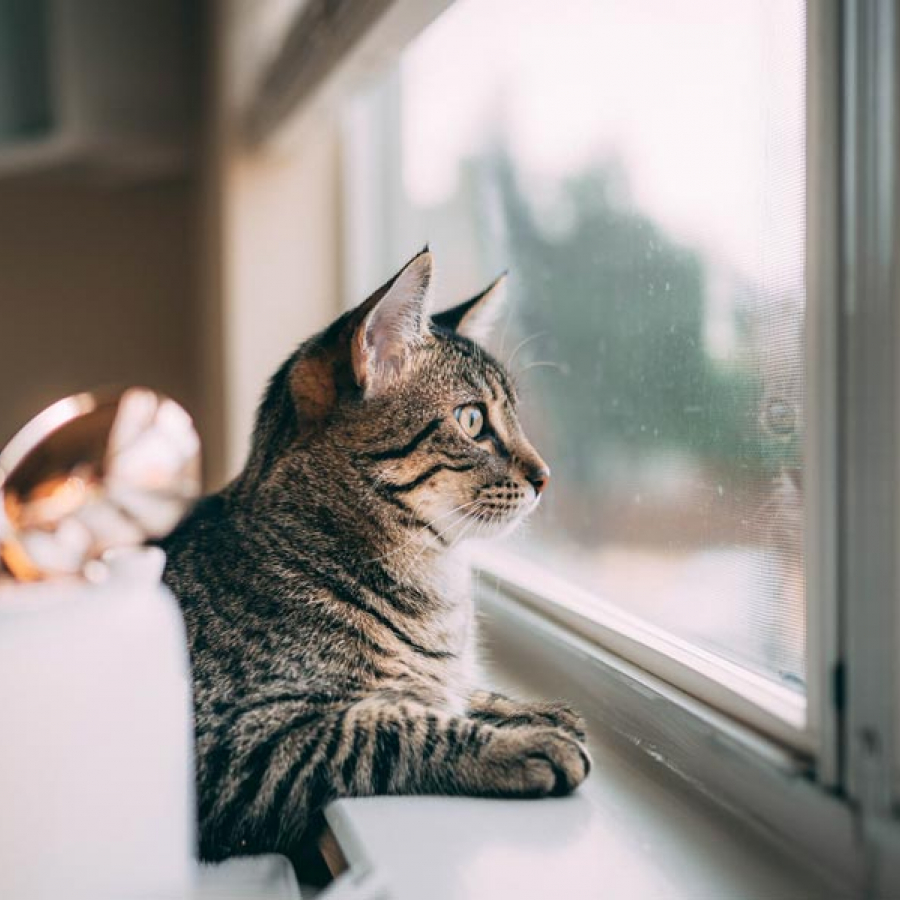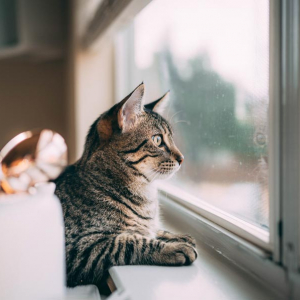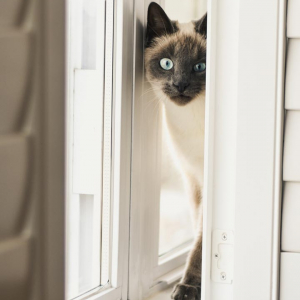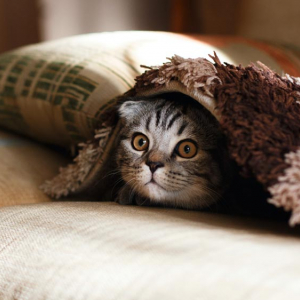How many times have you heard the phrase “curiosity killed the cat”? Fortunately for us cat lovers, the phrase is terribly misused compared to its origin. Our cat’s curiosity is a much-needed characteristic for survival amongst the feline species. Even though we think it’s cute to watch our pampered kitty “attack” the toy mouse, it all comes down to seven traits: intelligence, territorial, hunters, seeking protection, looking for attention, hunger and learning about their people.
In 1598, English playwright Ben Johnson wrote “Helter Skelter hang sarrow, care’ll kill a Cat, up-tails all, and a louse for the Hangman,” from his play Every Man in his Humour. When Johnson said ‘care’ he was referring to ‘sorrow/worry’ rather than ‘look after/care for.’ William Shakespeare was in the troupe that performed Johnson’s play. Therefore, a year later the quote “What, courage man! What though care killed a cat, thou hast mettle enough in thee to kill care” appeared in Much Ado About Nothing. Again, care references sorrow/worry, meaning being too involved in someone else’s business can get you in undesirable situations. Fast-forward to the 20th century, and we see the phrase take the contemporary form we know now: “Curiosity killed the cat, but satisfaction brought it back.” As the quote transforms from sorrow/worry to curiosity, we completely miss the science behind feline curiosity.
A cat’s curiosity is pure instinct, though they are super intelligent. Although cats may be too stubborn to follow in dogs’ footsteps with tricks, they are quite capable of learning. Cats in the wild use curiosity to investigate their surroundings, determine threats or prey and simply survive. Our friends at Cat Behavior Alliance explain how our cats are built for taking in information and determining their next step in survival. Starting with their excellent hearing—that is roughly five times better than ours—they can pinpoint where sounds originate. Cat whiskers detect vibrations in the air and help create a “map” of an area for nighttime exploration. A powerful sense of smell also lets cats know who or what has been in the area. These physical traits pair well with such intelligent felines as they explore a new area or hunt for food.
In our modern day, domestic cats may not need to hunt, but that doesn’t stop them from investigating. Have you ever noticed when you bring something new into your home, your cat is immediately checking it out? That plastic grocery bag or mail order box always piques a cat’s curiosity. Is the item a threat, is it prey, or is it simply something that is welcomed so Kitty can rub its face on or lay in it? A cat’s curiosity leads them to investigate everything or everyone new in their domain.
Curiosity helps cats hunt for food in the wild. Since they tend to go after small prey, they eat often. You’ll notice cats hiding, waiting to pounce in the grass or leaves as they hunt lizards and rodents. Of course, our indoor-only kitties will hide behind furniture then pounce on toy mice or insects that slip in through the door. Our kitties also love their time in the window. One may think cats just love to sun themselves, but many love watching what is going on outside. They enjoy watching birds and bugs and reacting to outdoor critters’ movement as if they are hunting. Either way, it is instinct, and they continue to carry on like their ancestors. A cat’s curiosity is also driven by their territorial nature. Ironically, they love to have a ‘bird’s-eye’ view of an area so they can keep a close eye on their domain. If they can’t get a clear perspective on the entire area, they will move periodically. When their person is moving from room to room, they will also move so they don’t miss any potential changes or items that need investigating.
Our territorial kitties love to learn about everything in their domain, especially their people. Cats want to sniff us, rub on us, and learn our habits. In a cat’s mind, if we are part of the cat’s domain, then we must belong to them. They really do take notes to get what they want! This research helps the kitty learn when to eat, how to get treats, how to get pets and when is a good time to cuddle. Is it safe to say this trait proves the saying, “Dogs think they are people; cats think they are god”?
Seeking protection is a necessary trait for effective hunting and survival. A cat’s hideout allows Kitty a safe place to take an undisturbed nap. It has been recorded cats sleep an average of 12–16 hours per day to support their hunting and nocturnal habits. Jumping out from a safe place is a hunting skill, for example. Of course, our domestic kitties don’t need to hunt, but they can’t seem to overrule instinct. During playtime, a hiding place gives Kitty a haven to strategically ‘attack’ another kitty friend or human.
Ever find yourself with a day you can sleep in? Then you must not have a cat. When your cat is hungry, Kitty knows what time to start asking. Same time each morning, you are awakened with meows, purrs and fuzzy tails in your face. Cats learn quickly how to manipulate you to feed them food or treats. You may think they have a watch on the left front paw—they are constantly checking! Let’s just say: our kitties have us well trained.
Working from home became our form of survival during the pandemic, and it is here to stay! Many people think cats are self-sufficient, but we all learned quickly how much they love us being around. We all have stories of our cats walking into a video call or laying across our keyboard while we work. The fact is that they love their people and want our attention. Cats will jump in your lap, curl up and turn on the purr. They will greet you when you get home and follow you with meows and leg rubs. In a nutshell: cats can be very demanding, but they are so worth it!
Learning about the instinct that drives a cat’s curiosity allows us to look at their actions from a different perspective. If you ever wondered if investing in the tall cat tree is worth it, now you understand why it may make your fur baby happy. Next time your kitty lays across the keyboard, maybe it’s time to take a break and give kitty some love. Based on the traits we learned above, our kitties have plenty to say. Thankfully, curiosity doesn’t kill our cat.
In 1598, English playwright Ben Johnson wrote “Helter Skelter hang sarrow, care’ll kill a Cat, up-tails all, and a louse for the Hangman,” from his play Every Man in his Humour. When Johnson said ‘care’ he was referring to ‘sorrow/worry’ rather than ‘look after/care for.’ William Shakespeare was in the troupe that performed Johnson’s play. Therefore, a year later the quote “What, courage man! What though care killed a cat, thou hast mettle enough in thee to kill care” appeared in Much Ado About Nothing. Again, care references sorrow/worry, meaning being too involved in someone else’s business can get you in undesirable situations. Fast-forward to the 20th century, and we see the phrase take the contemporary form we know now: “Curiosity killed the cat, but satisfaction brought it back.” As the quote transforms from sorrow/worry to curiosity, we completely miss the science behind feline curiosity.
A cat’s curiosity is pure instinct, though they are super intelligent. Although cats may be too stubborn to follow in dogs’ footsteps with tricks, they are quite capable of learning. Cats in the wild use curiosity to investigate their surroundings, determine threats or prey and simply survive. Our friends at Cat Behavior Alliance explain how our cats are built for taking in information and determining their next step in survival. Starting with their excellent hearing—that is roughly five times better than ours—they can pinpoint where sounds originate. Cat whiskers detect vibrations in the air and help create a “map” of an area for nighttime exploration. A powerful sense of smell also lets cats know who or what has been in the area. These physical traits pair well with such intelligent felines as they explore a new area or hunt for food.
In our modern day, domestic cats may not need to hunt, but that doesn’t stop them from investigating. Have you ever noticed when you bring something new into your home, your cat is immediately checking it out? That plastic grocery bag or mail order box always piques a cat’s curiosity. Is the item a threat, is it prey, or is it simply something that is welcomed so Kitty can rub its face on or lay in it? A cat’s curiosity leads them to investigate everything or everyone new in their domain.
Curiosity helps cats hunt for food in the wild. Since they tend to go after small prey, they eat often. You’ll notice cats hiding, waiting to pounce in the grass or leaves as they hunt lizards and rodents. Of course, our indoor-only kitties will hide behind furniture then pounce on toy mice or insects that slip in through the door. Our kitties also love their time in the window. One may think cats just love to sun themselves, but many love watching what is going on outside. They enjoy watching birds and bugs and reacting to outdoor critters’ movement as if they are hunting. Either way, it is instinct, and they continue to carry on like their ancestors. A cat’s curiosity is also driven by their territorial nature. Ironically, they love to have a ‘bird’s-eye’ view of an area so they can keep a close eye on their domain. If they can’t get a clear perspective on the entire area, they will move periodically. When their person is moving from room to room, they will also move so they don’t miss any potential changes or items that need investigating.
Our territorial kitties love to learn about everything in their domain, especially their people. Cats want to sniff us, rub on us, and learn our habits. In a cat’s mind, if we are part of the cat’s domain, then we must belong to them. They really do take notes to get what they want! This research helps the kitty learn when to eat, how to get treats, how to get pets and when is a good time to cuddle. Is it safe to say this trait proves the saying, “Dogs think they are people; cats think they are god”?
Seeking protection is a necessary trait for effective hunting and survival. A cat’s hideout allows Kitty a safe place to take an undisturbed nap. It has been recorded cats sleep an average of 12–16 hours per day to support their hunting and nocturnal habits. Jumping out from a safe place is a hunting skill, for example. Of course, our domestic kitties don’t need to hunt, but they can’t seem to overrule instinct. During playtime, a hiding place gives Kitty a haven to strategically ‘attack’ another kitty friend or human.
Ever find yourself with a day you can sleep in? Then you must not have a cat. When your cat is hungry, Kitty knows what time to start asking. Same time each morning, you are awakened with meows, purrs and fuzzy tails in your face. Cats learn quickly how to manipulate you to feed them food or treats. You may think they have a watch on the left front paw—they are constantly checking! Let’s just say: our kitties have us well trained.
Working from home became our form of survival during the pandemic, and it is here to stay! Many people think cats are self-sufficient, but we all learned quickly how much they love us being around. We all have stories of our cats walking into a video call or laying across our keyboard while we work. The fact is that they love their people and want our attention. Cats will jump in your lap, curl up and turn on the purr. They will greet you when you get home and follow you with meows and leg rubs. In a nutshell: cats can be very demanding, but they are so worth it!
Learning about the instinct that drives a cat’s curiosity allows us to look at their actions from a different perspective. If you ever wondered if investing in the tall cat tree is worth it, now you understand why it may make your fur baby happy. Next time your kitty lays across the keyboard, maybe it’s time to take a break and give kitty some love. Based on the traits we learned above, our kitties have plenty to say. Thankfully, curiosity doesn’t kill our cat.
Tagged in Kitty Korner in our Summer 2022 issue







